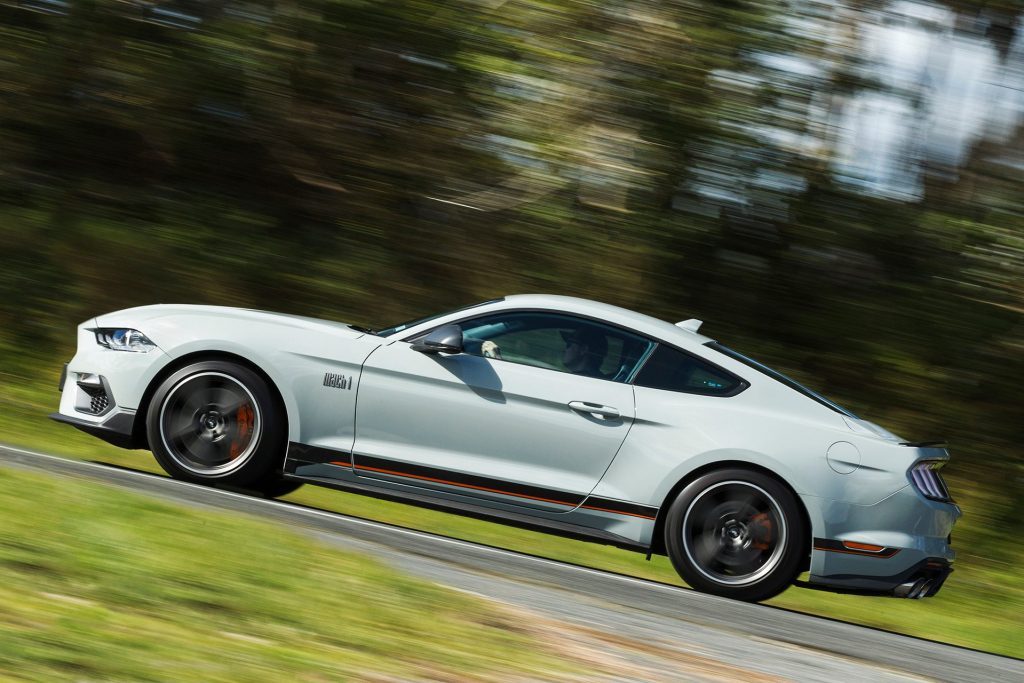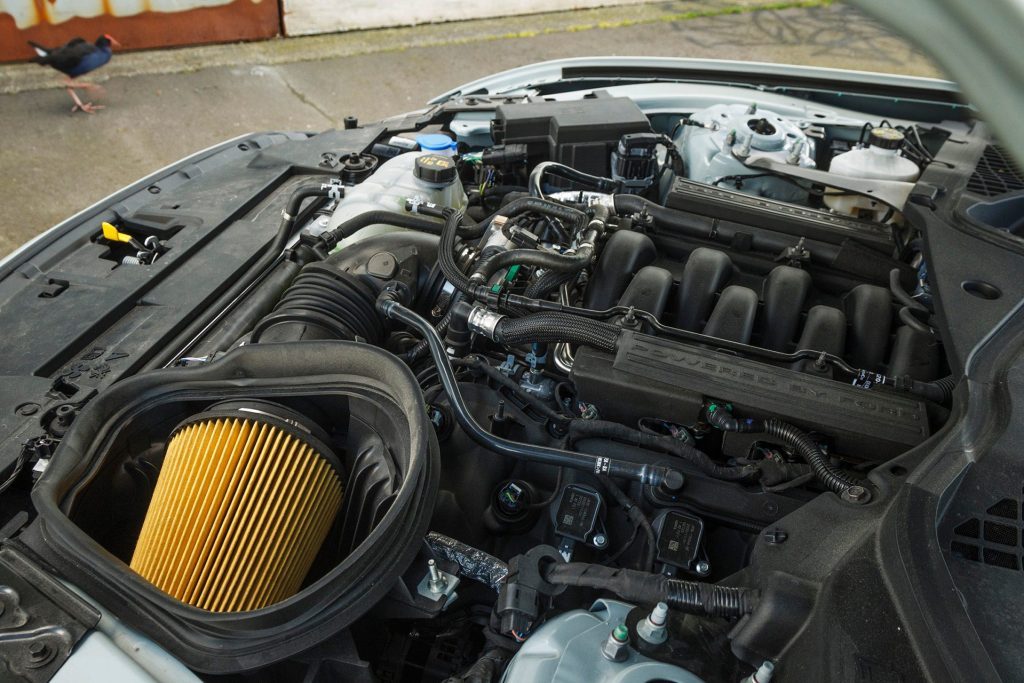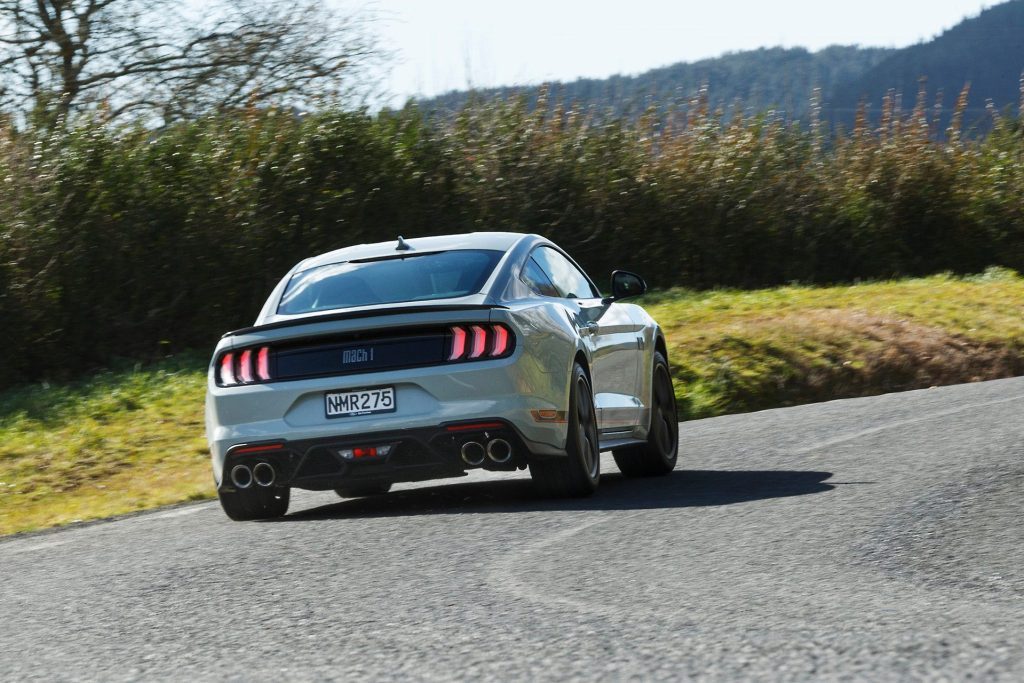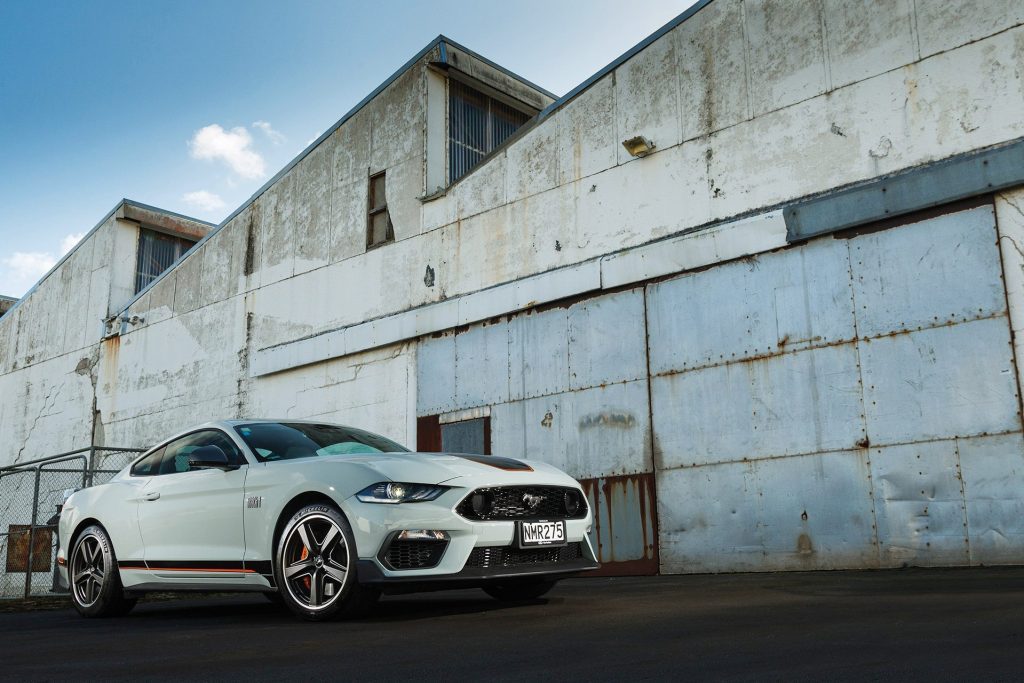Ford is never one to let a nameplate languish. Especially when it comes to money-making special-edition Mustangs. Following on from the Bullitt, Ford announced a new Mach 1 last year, touted as being the ‘most track-capable 5.0-litre Mustang yet’. This gives you the general gist of the model’s raison d’etre. In the US, this fills the gap between the GT and the 760-horse GT500 as the GT350 and the ‘Performance Pack’ Mustang are no longer a thing. It also harks back to the heritage of the Mach 1 nameplate, first seen in 1969 and devised to bridge the gulf between the regular GT and Shelby-fettled models. And in true Ford fashion, the Mach 1’s enhancements come from the parts bin, with bits borrowed from the Shelby models.
The 5.0-litre V8 gains the larger, 87mm throttle body and intake system from the GT350 to help it breathe and it pulls 345kW at a ripsnorting 7500rpm, with 556Nm of torque at 4600rpm. Available with both the ten-speed auto and the six-speed manual, those opting for the latter swap cogs via the Shelby GT350’s more robust Tremec TR-3160 trans. In line with the track emphasis, the Mach 1 gets stiffer sway bars and front springs, and the GT350’s front subframe, while the rear unit is mounted on stiffer bushes and uses GT500 rear toe links. To maximise the gains, the Mach 1 has retuned steering and revised MagneRide adaptive dampers. And to help it endure track days, there’s a rear axle cooler and an added engine oil cooler while air flow underneath is managed to cool the brakes more effectively. Speaking of aeros, the front splitter and rear diffuser help reduce lift at speed.

The full-blown, US-spec Mach 1 gets more power (less here due to emissions), a Torsen diff with a lower 3.73 final drive (ours has the usual GT-spec 3.55 LSD) and the ‘Handling Option’. This consists of even more aero via a bigger front splitter and rear wing. It also gets wider (and cooler looking) wheels, with 305 cross section rubber on the front, and fat 335s on the rear.
The alloys on this ‘regular’ Mach 1 are said to be a modern take on the old Magnum 500’s, while Mach 1s in ‘Fighter Jet’ grey get the orange brake calipers in behind to match the black and orange stripe pack.
The Mach 1 was $97,990. We use the past tense as it was announced last year and the limited run of 50 cars for NZ was snapped up quick smart, 23 opting for the manual, and grey the most popular choice.

Being honest, given the choice to drive the new Mach-E or this Mach 1, the novel electric version probably is more tempting. But once we pressed the Mach 1’s starter, the noise of the big planet warmer awakening soon dissolved any aspirations to drive the Mach-E.
This sounds utterly marvelous via the Mach 1’s variable exhaust, which truly bellows in Race Track mode. And you can enhance that melody by flopping the rear seat down to let that exhaust note reverberate around the cabin. That’ll help battle the unwanted din from the roaring rubber at speed.
The V8 is a gem. We are used to boosted Euro eights these days, which pull from anywhere, whereas this is a revvy, cammy motor. There’s basement level torque for ambling about, but from 3500rpm onwards, it goes Mach 1. It revs, and revs, pulling the long gears, the power hanging on in, and then as it homes in on 7500rpm, bam, you whack the limiter. It’s quite something for a mass-produced mill. The heavy duty Tremec six-speeder is heavier in its thow than the usual GT unit, yet it finds its way quite easily through the well defined gates. Can’t remember how to heel and toe? An auto blipping function smoothes the downshifts. If you’re up for the challenge, you can turn it off. The 380mm front rotors and six-pot Brembos are reassuring, with a good initial bite and a meaty pedal feel. The Mach 1 is no lightweight, it’s American in every sense, but it does haul up well, remaining stable under heavy inputs.

However, it’s the lateral grip this pulls that is something else, especially with that big V8 lump over the front. It holds on keenly and the sort of cornering grip it generates through longer sweepers is stunning. And yet it buries its nose into the apex of the tight ones too. This does seem a tad keener on the turn, the responses sharper. No doubt it all works better on track, when you can really generate some heat into those Michelin Pilot Sports. The long travel throttle helps manage the traction, as does the power delivery, which is responsive but not snappy.
The MagneRide is a tad firm on road in the Sport plus drive mode (Track is jarring) but you live with it, even if it doesn’t manage to ride the bumps as well as it should. Helping track aspirations are long legs, the legal limit reached in second gear with a good deal still to go.
Fuel use can be horrendous when the revs are used, but when merely cruising you might get into the 12s, while the overall figure is quoted at 13.9L/100km. Good fun, pity about the climate emergency though.

The street ride in Normal is firm but you can set the steering to Comfort mode to rid it of the otherwise heavy weighting. Its clutch is easy going considering the torque, with a defined engagement and even a hill holder function. There is a smattering of safety devices, and the usual Mustang frustrations like the user-unfriendly driving mode switch, the ill-placed cup holders and the mess of buttons around the steering wheel. The standard-fit Recaros are grippier around the midsection though not overly bolstered on the squab, so you can get in without any bodily harm.
None of this really matters however as most Mach 1s were probably trailered home, and rolled into a carpeted garage, likely to be parked up next to a nice 1969 example. Like the sea level, its price is sure to rise in future.
| Model | Ford Mustang Mach 1 |
| Price | Sold out |
| Engine | 5038cc, V8, EFI, 345kW/556Nm |
| Drivetrain | 6-speed manual, RWD |
| Fuel Use | 13.9L/100km |
| C02 Output | 320g/km |
| 0-100km/h | 5.1sec |
| Weight | 1779kg |


